Top Sights of Bangkok
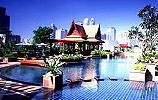
| 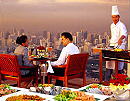
| Bangkok Hotels | 
| 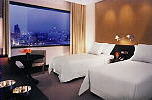
|
The Grand Palace
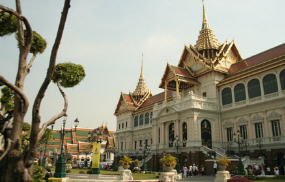
|
Inside the Royal Grand Palace are the Maha Monthien group of buildings, the Throne Halls, and other palaces and buildings. These have been renovated, refurbished, repaired, extended and added to continually as appropriate to every reign since then.
Chakri Throne Hall Hybrid Thai-European architecture built in the reign of King Rama V with the throne hall itself in European style and the roof in a Thai throne hall style.
Chakrapatpiman Throne Hall The chief throne hall of the Monthien group, and the early Chakri kings mostly stayed in this throne hall.
Dusit Throne Hall Cruciform style built in the reign of King Rama I. Inside is a Throne decorated in pearl and Phratanratchabanjathorn, a couch of King Rama I.
Royal Decorations & Coins Division Ranks and coinage has 13 exhibition rooms: Rooms 1-3, royal ranks; Room 6, the apparel of the Emerald Buddha which is changed according to season; Room 7, royal regalia and Room 12, historical money etc.
Address: The Royal Decorations & Coins Division: On the right side of the main entrance of Wat Phra Kaeo.
Tel: (662) 224-3328 226-0255 , Fax:(662) 225-9158
Opening Hours: Daily 9 am-4 pm
Admission Fee: Thai 10 Bht
Guide: Must be in group of 10 or more, with written request one week in advance to the Director of Currency Management Bureau
Prohibited: Taking photo inside Bldg. Shopping:1 st fl.
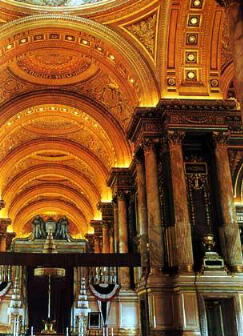
|
Dome Ceiling Frescoes depict the monarch, of the Chakri Dynasty and important works of those from King Rama I to King Rama VI are featured or, the ceiling of the dome. The rotunda under which the Royal throne is placed has been used for state ceremonies. The Anantasamakom Throne Hall has played an important role in Thai political history. It reflects the bond between Royal and political institutions since the day when King Rama VII affixed his signa ture to give the Thai people their first constitution. The first meeting of the Thai parliament Convened in this hall.
Address: Uthongnai Road Dusit Su6-District Dusit District Bangkok 10300
Phone: (662) 2441549 2441557-60 , Fax:(662) 2441558
Bus: 70 72 / Air-con Bus: 3
Opening Hours: Children's Day (2nd Sat of Jan)
Admission Free: Free Admission
Parking: In front of the Bldg.
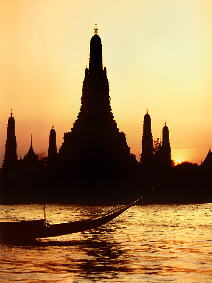
|
Ubosot: This is an outstanding example of Rama II period architecture in late Ayutthaya style. It has a two-tiered roof with glazed ceramics, and pediments decorated with wooden carvings depicting Warunthep. The interior murals were painted during the Third and Fifth Reigns. Phra Phutthathammitsararatchalokthatdilok,the principal Buddha image in the Subduing Mara posture, was cast in the reign of King Rama II and contains relics of King Rama II.
Prang: This brick stupa is decorated with glazed pottery fragments in flower and leaf designs and other Thai patterns. The top is gilded and adorned with the noppasul.
Pra Rabiengkote: This corridor is in place of the kampaeng kaeo found in most other temples. It has a tiled roof with doors opening onto f directions. Inside are 120 Buddha images in Subduing Mara posture.
Mondop of the Buddha's Footprint: A chapel surmounted by a spire, this stands between the ubosot and the wihan. It was built during the Third Reign and houses a copy of the footprint of the Budd a carved in Kwantong stone and decorated with colourful porcelain.
Ogre Statues: Guarding at the gate are two ogre (yaksha). The white yaksha is Sahassadecha and the green partner Thossakun, the villain of the Ramakien, the Thai version of the Ramayana epic.
The temple has flourished throughout the Rattanakosin period. The beauty of the architecture and the fine craftsmanship declare its status as a temp - of the first grade and one of the most outstanding temples of Thailand.
Address: 34 Arun Amarin Road, Wat Arun Sub-District, Bangkokyai District, Bangkok 10600
Phone:(662) 891-1149 / Fax:(662) 891-1149
Bus:19 57 83
Pier: 1. Passenger Boat: Wat Arun Pier / 2. Ferry: Tha Tien Pier - Wat Pho Pier F<--> Wat Arun Pier
Opening Hours: Temple: Daily 7:30 am-5:30 pm / Ubosot: Free Admission, but a written request to the Temple's Abbot is required.
Admission Fee: Prang: 10 Bht
Parking: in the Temple compound.
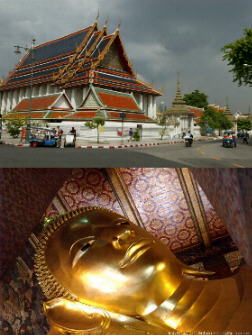
|
Once inside this complex you can't help to wonder what is the purpose of all these buildings. There are many reason behind that. Come and find out for yourself. Wat is the Thai term meaning "Religious Complex", "Temple".
Address: 2 Sanamchai Road, Phra Borommaharatchawang Sub-District, Phra Nakhon District, Bangkok 10200
Telephone: (662) 222-5910 226-2942 226-1743 / 225-9595 / Fax: (662) 225-9779
Bus: 1 3 6 9 12 25 32 43 44 47 48 53 60 82 91 123 / Air-con Bus: 8 9 25 44 82 91 506 507 512
Pier: 1.Chao Phraya Express Boat Rajini (Pakkhlong Talat) Pier Tha Chang Pier, Tha Tien Pier / 2. Ferry: Rajini (Pakkhlong Tolat) Pier Tha Chang Pier - Tha Tien Pier
Parking: In the Temple compound
Opening Hours: Temple: Daily 8 am-5 pm / Ubosot: Daily 8 am-5 pm
Admission Fee: Foreigners 20 Bht
Museum: Wat Phrachetuphon: Wasukree Mansion
School-University: Wat Pho Thai Traditional Medical and Massage - Telephone: (662) 221-2874 225-4771 - Enrollment: Daily 8 am-5 pm Class: Sat, Sun 8 am-5 pm
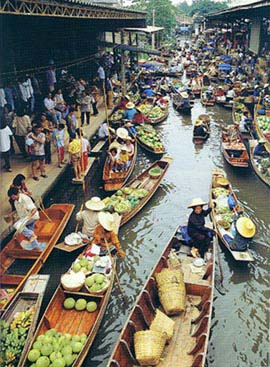
|
The best time to make a canal boat trip would be around six o'clock in the morning in order to capture the authentic atmosphere and the varied activity which begins early in the day: Monks receiving alms, children hurrying to chool, and boats delivering vegetables from far away to markets.
Boat trips in the afternoon are best taken after 2 p.m. to avoid the heat of the mid-day sun. Th traditional Thai lifestyle can still be found at several waterways such as the Daokanong, Ba khunthien and Lart canals. Here visitors can discover the more tranquil face of life in Bangkok.
A tour might begin with a visit to the National Museum of the Royal Barges, then Wat Suwannaram. After that, go to see the Guanyin, feed the Swai fish (Pangasius foroleri), and visit Sala Karnparian at Wat Shepakhao. Then go to Khlong Chakpra for lunch at Talingchan Floating Market. From there, go to the floating ubosot of of Wat Phigunthong. Finally, pay a visit to the Sukhothai ubosot in the old merchant ship Sumpaoshape at Wat Chalor.
Address:
1. Passenger Boat: Tha Chang Pier / Raiini Pier (Pakkhlong Talat) Memorial Bridge Pier Oriental Pier - Business Hours: Daily 6 am-2 pm (Price according to hours used)
2. Mitr Chao Phraya Express: Boat: Daily 8 am 10 - Phone:(662) 225-6179
Parking: At the Pier compound
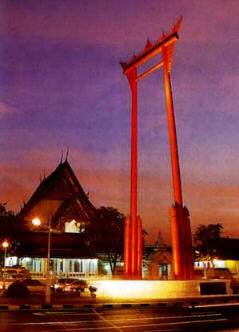
|
The Swing Ceremony originates from a story in the scriptures. Concerned about the end of the world, Uma Devi contrived a bet with Shiva. A serpent was suspended between Putsa trees (Jujube) on the river, swinging back and forth between them. Shiva stood in its path on one leg with the other crossed. If the serpent struck Shiva and he fell, that would signify that the world would end. But Shiva did not fall, proving that the whole of creation was secured and strong, so Shiva won. The Swing Ceremony compares the swing to the Putsa trees, while the space between its posts is the river. Naliwan is the serpent, with Phraya Yuen standing cross-legged on a benjamas wood.
King Rama I ordered it to built in front of the Devasathan at the centre of the city. It was moved to its present position in the reign of King Rama V, to make room for a gas plant. The ceremony was removed from the list of royal ceremonies in the reign of King Rama VII. At present, it may still be held with Royal sponsorship, but only in the Devasathan.
Address:In front of Wat Suthat Bamrung, Muang Road, Sao Chingcha Sub-District, Phra Nakhon District, Bangkok 10200
Bus: 10 12 19 35 42 56 96 / Air Con Bus: 42
|
Bangkok
 |
